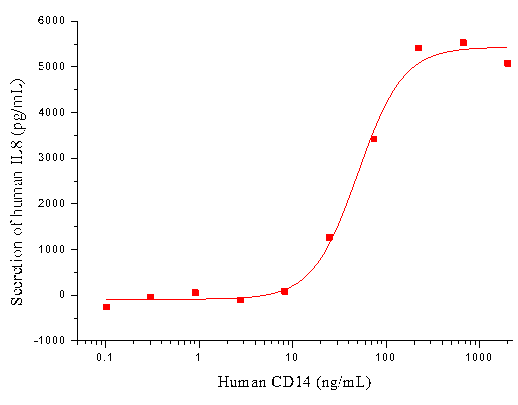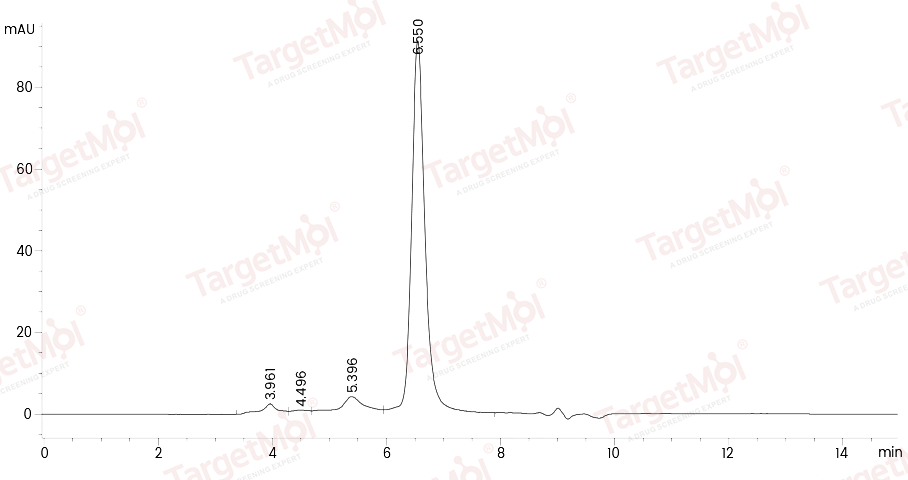Shopping Cart
- Remove All
 Your shopping cart is currently empty
Your shopping cart is currently empty

CD14 Protein, Human, Recombinant (His) is expressed in HEK293 mammalian cells with His tag. The predicted molecular weight is 36.5 kDa and the accession number is P08571.

| Pack Size | Price | Availability | Quantity |
|---|---|---|---|
| 100 μg | $228 | In Stock | |
| 200 μg | $448 | 7-10 days | |
| 500 μg | $1,690 | 7-10 days |
| Biological Activity | Measured by its ability to enhance LPS stimulated IL8 secretion by THP1 human acute monocytic leukemia cells. The ED50 for this effect is typically 25-95 ng/mL.  |
| Description | CD14 Protein, Human, Recombinant (His) is expressed in HEK293 mammalian cells with His tag. The predicted molecular weight is 36.5 kDa and the accession number is P08571. |
| Species | Human |
| Expression System | HEK293 Cells |
| Tag | C-His |
| Accession Number | P08571 |
| Synonyms | monocyte differentiation antigen CD14,CD14 molecule,CD14 antigen |
| Construction | A DNA sequence encoding the mature form of human CD14 (NP_000582.1) (Met 1-Met 344) was fused with a polyhistidine tag at the C-terminus. Predicted N terminal: Thr 20 |
| Protein Purity | ≥ 97 % as determined by SDS-PAGE. ≥ 85 % as determined by SEC-HPLC.   |
| Molecular Weight | 36.5 kDa (predicted); 45 kDa (reducing condition, due to glycosylation) |
| Endotoxin | < 1.0 EU/μg of the protein as determined by the LAL method. |
| Formulation | Lyophilized from a solution filtered through a 0.22 μm filter, containing PBS, pH 7.4. Typically, a mixture containing 5% to 8% trehalose, mannitol, and 0.01% Tween 80 is incorporated as a protective agent before lyophilization. |
| Reconstitution | A Certificate of Analysis (CoA) containing reconstitution instructions is included with the products. Please refer to the CoA for detailed information. |
| Stability & Storage | It is recommended to store recombinant proteins at -20°C to -80°C for future use. Lyophilized powders can be stably stored for over 12 months, while liquid products can be stored for 6-12 months at -80°C. For reconstituted protein solutions, the solution can be stored at -20°C to -80°C for at least 3 months. Please avoid multiple freeze-thaw cycles and store products in aliquots. |
| Shipping | In general, Lyophilized powders are shipping with blue ice. |
| Research Background | The cluster of differentiation (CD) system is commonly used as cell markers in immunophenotyping. Different kinds of cells in the immune system can be identified through the surface CD molecules associating with the immune function of the cell. There are more than 320 CD unique clusters and subclusters have been identified. Some of the CD molecules serve as receptors or ligands important to the cell through initiating a signal cascade which then alter the behavior of the cell. Some CD proteins do not take part in cell signal process but have other functions such as cell adhesion. Cluster of differentiation 14 (CD14) is a member of the CD system. It takes its name from its inclusion in the CD molecule surface marker proteins. CD14 exists in two forms: a form anchored into the membrane or a soluble form. CD14 was found expressed in macrophages, neutrophil granulocyte and dendritic cells. The major function is to serve as a co-receptor (along with TLR4 and MD-2) for the bacterial lipopolysaccharide (LPS) and other pathogen-associated molecular patterns. |

Copyright © 2015-2025 TargetMol Chemicals Inc. All Rights Reserved.